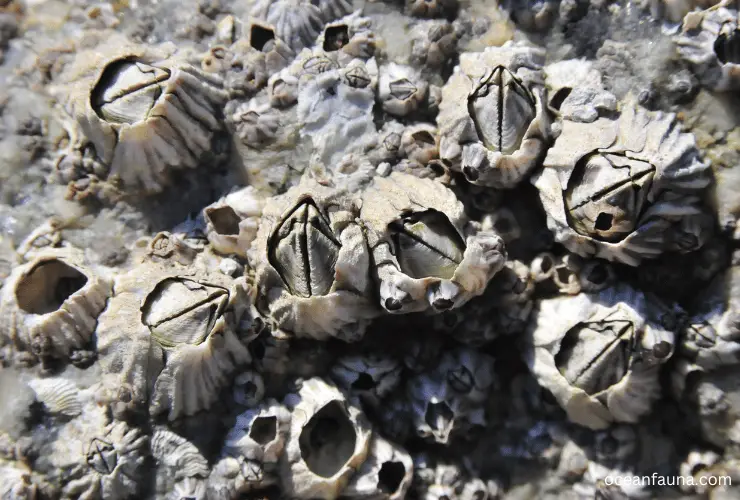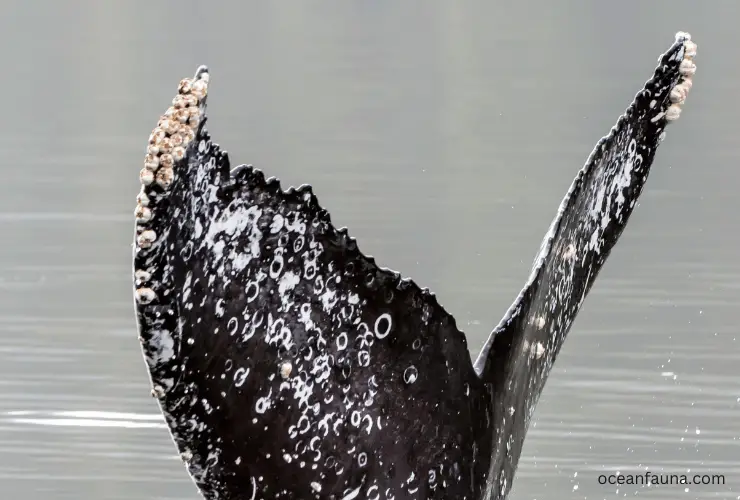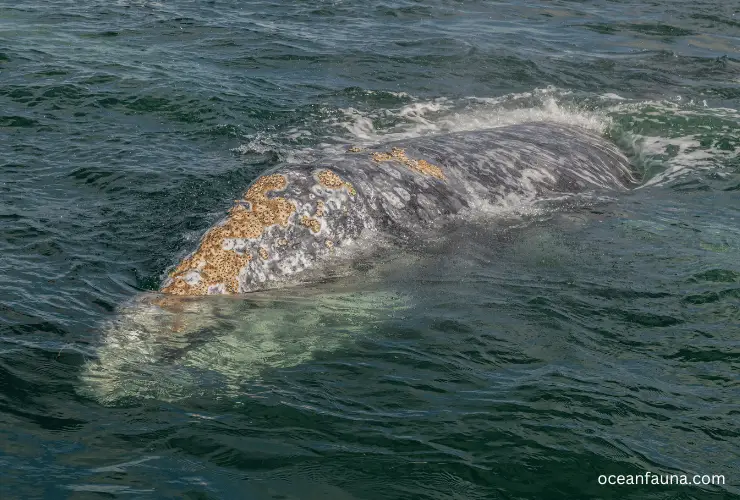The relationship between barnacles and whales is fascinating and raises some interesting questions. Do barnacles hurt whales when they attach to their skin?
The answer is no! Barnacles don’t hurt whales. Barnacles attach to whales for riding and movement purposes. They don’t feed on whales.
Read this full article to learn more about the relationship between barnacles and whales.
Can Barnacles Move?
As mentioned above, barnacles attach to the whales mainly for riding purposes. But does it mean that barnacles can’t move? What is the truth?
Well, some barnacles are capable of movement but very slow. The turtle barnacles (Chelonibia testudinaria) have been found to move approximately 1.4 millimeters per week on turtles’ shells. This movement allows them to improve their feeding position, as they are filter feeders and require a constant flow of water to bring food to them.

However, barnacles are not considered as mobile creatures in the traditional sense. Once they find a suitable location to settle, they attach themselves to a solid substrate, such as rocks, pilings, or the shells of marine animals.
From that point on, they remain in one place for the duration of their adult life. Barnacles are considered sessile animals, which means they do not move once they have settled. Other examples of sessile animals include mussels and coral.
When barnacles are in their juvenile stage, they are able to swim and search for a suitable place to settle. Once they have found a suitable substrate, they attach themselves to it and begin their growth into their adult form.
Now, barnacles that attach to whales remain in a fixed position and use the whale as transportation. They are filter feeders and depend on the whale’s movement to constantly provide them with water, enabling them to feed and grow without having to move independently.
Based on their location and life stage, barnacles can be classified as mobile and sessile.
Relation Between Barnacles and Whales
Barnacles and whales have a unique relationship that falls under the category of commensalism. Commensalism is a type of symbiotic relationship in which one species benefits from the interaction while the other is neither harmed nor helped.

In this case, barnacles attach themselves to the skin of whales and utilize them as a stable platform to live on, a mobile environment that enables them to move to different locations for feeding, and a consistent source of food.
Barnacles are crustaceans that have a sessile lifestyle, meaning they remain fixed in one location. They need a solid substrate to attach themselves to, and the skin of whales provides a perfect living space for them.
They secrete a type of cement to attach themselves to the whales’ surface, which is a mutualistic relationship as it doesn’t harm whales in any way.
Barnacles grow and reproduce on the skin of whales, and they also enjoy protection from predators, as the constant movement of the whales makes it difficult for them to be located by predators.
As for the whales, having barnacles on their skin doesn’t affect them negatively in any way. In fact, barnacles on the skin of whales may create some drag, but it is negligible.
Whales don’t have any direct benefits from barnacles, but it doesn’t cause them any harm either. Therefore, this relationship between barnacles and whales is a prime example of commensalism.
Which Barnacles Attach to Whales?
Many species of barnacles attach to whales, but the most well-known is the whale barnacles, a type of acorn barnacle belonging to the family Coronulidae. These barnacles attach to baleen whales and occasionally to toothed whales, using a long, flexible stalk to anchor themselves to the whale’s skin.
The whale barnacles are thought to have diverged from their closest relatives, the turtle barnacles, around three million years ago.

While some species of barnacles are generalists and can be found on various hosts, the most common barnacle species found on gray whales are host-specific, meaning they only occur on this particular whale species. One such example is Cryptolepas rhachianecti, which attaches exclusively to gray whales.
Once the barnacle has settled on “its own” whale, it spends the rest of its life hanging onto the host, even during long migrations. This lifetime attachment has resulted in some interesting adaptations, such as reduced mobile limbs and a highly developed adhesive gland system that helps the barnacle stay put.
All these barnacles are non-parasitic, which means they don’t feed on or harm the whale in any way, and they simply take advantage of the whales’ movements to travel around and get food.
How Do Barnacles Attach to The Whales?
Barnacles attach to the skin of whales by a process called “suction adhesion.” This method involves the extension of a long, muscular stalk which is used to grasp onto the whale’s skin while the rest of the animal’s body remains safely inside its protective shell.
Whale barnacles are uniquely adapted to attach to their hosts’ smooth, constantly moving skin, using modified appendages called “cirri” to create a tight seal against the surface. To ensure a reliable grip, these cirri are equipped with tiny, hair-like structures called “setae,” which can penetrate the whale’s skin and anchor the barnacle in place.
Once attached, the barnacle pumps water through specialized organs known as “corral pumps,” which create a powerful suction force, keeping the animal firmly in place even in turbulent conditions. This suction force is so strong that removing a barnacle from a whale’s skin can be incredibly difficult.
Do Barnacles Hurt Whales?
No, barnacles do not harm whales. In fact, they are considered non-parasitic barnacles, which means they do not feed on or harm the whales in any way. The presence of barnacles does not negatively affect the health and well-being of the whales in any way. They protect them from predators by offering a physical barrier, but that is about it.
[Note: Excessive growth of barnacles may cause energy loss, skin abrasions, and an increase in the metabolic rate of whales.]
Do Whales Feel the Barnacles?
Whales generally do not feel the presence of barnacles on their skin. This is because the barnacles attach themselves to the whale’s skin through cementation.

During this process, the barnacles secrete a type of glue that allows them to firmly attach themselves to the whale’s skin. As a result, the barnacles do not cause any irritation or discomfort to the whale.
The weight of the barnacles on a whale is also not significant enough to have any negative effects on the whale’s health. A colony of barnacles can weigh up to 1,000 pounds, but for a 30-ton humpback whale, it is equivalent to wearing an additional layer of clothing for a human. Therefore, the barnacles don’t hinder the whale’s movement or slow down its swimming speed.
Moreover, barnacles on a whale’s skin are actually beneficial in a way. They provide food for other marine animals that prey on them. They also aid the whale in camouflage by breaking up its outline, making it more difficult for predators to spot.
Why Do Barnacles Attach to Whales?
Here is why barnacles attach to whales and the benefits they derive from this symbiotic relationship.
Physical Environment:
Whales are often found swimming in the open ocean, which means they are constantly exposed to waves, currents, and other elements. Barnacles attach themselves to the rough skin of whales using their powerful cementing glands, and the whales provide an ideal environment for them to live in. The rough surface of a whale’s skin gives the barnacles a stable place to attach, and they are less likely to be washed away by strong currents than if they were attached to a rock or some other static surface.
Food:
Barnacles are filter feeders, which means they need a constant supply of food to survive. Fortunately for them, whales are constantly moving through the water, creating currents that bring in a steady stream of plankton and other small organisms. This provides a rich source of food for the barnacles, which can filter up to 250 liters of water per hour to feed.
Protection:
Whales are massive animals, which means they are less susceptible to predation than smaller marine creatures. This provides a safe haven for the barnacles, which are more vulnerable to attack from predators such as crabs and starfish. By attaching themselves to a whale’s skin, they are protected from these predators and gain an evolutionary advantage.
What Do Whales Do to Get Rid of Barnacles?
Do whales try to remove barnacles? The answer is “Yes.” When barnacles grow excessively, whales use various methods to get rid of them that accumulate on their skin. The following are some ways that whales remove barnacles from their skin:
Rubbing against rocks or gravelly seafloor
Gray whales have been observed rubbing against the gravelly seafloor to dislodge barnacles. They often roll on their sides and twist their bodies to remove the barnacles clinging to their skin. The abrasive texture of rocks and gravel helps scrape the barnacles from their skin.
Rubbing against other objects
Whales also rub against other objects, such as boats, buoys, or even each other, to remove barnacles. Rubbing against rough surfaces helps to remove the barnacles from their skin. However, this behavior can also damage the whales’ skin and make them susceptible to infections.
Using their flippers or tails
Some whales use their flippers or tails to remove barnacles from hard-to-reach areas of their skin. By thrashing their flippers or tails, they create turbulence in the water that dislodges the barnacles from their skin.
Having parasites eat the barnacles
Certain species of whales have parasites, such as whale lice, that feed on the barnacles that attach to their skin. Gray whales, for example, feed on bottom sediments and scrape off barnacles and whale lice as they feed. This helps to keep their skin clean and free from barnacles.
Migrating to colder waters
Some species of whales, such as humpback whales, migrate to colder waters with fewer barnacles. Colder waters also help slow the growth rate of barnacles, making it easier for the whales to remove them.
Conclusion
Now, you know that barnacles on whales have a mutually beneficial symbiotic relationship. Whales provide the barnacles with shelter, food, and protection from predators. In return, barnacles help to clean the whales’ skin by filter-feeding on plankton and other small organisms.
Whales can’t completely remove barnacles from their skin even though they try. So they have developed various ways to manage these barnacles, including rubbing against rocks or objects, using their flippers or tails to remove them, and moving to colder waters with fewer barnacles.
Keep your question in the comment section if you want to know more about barnacles and whales. I will answer them as soon as possible.

